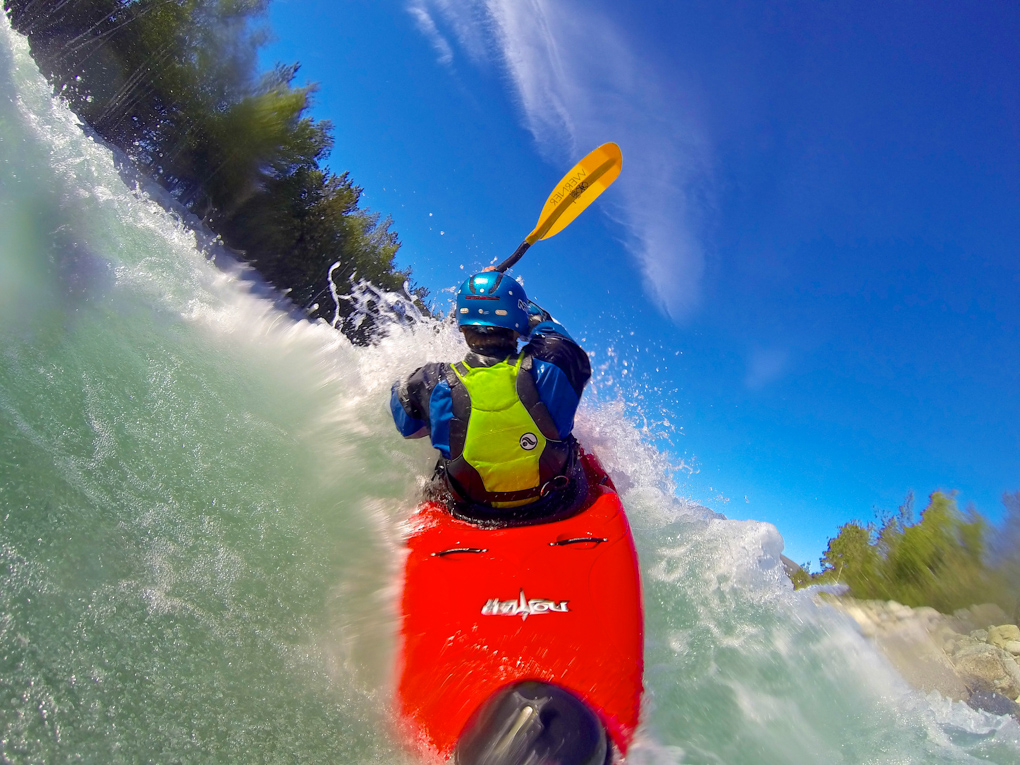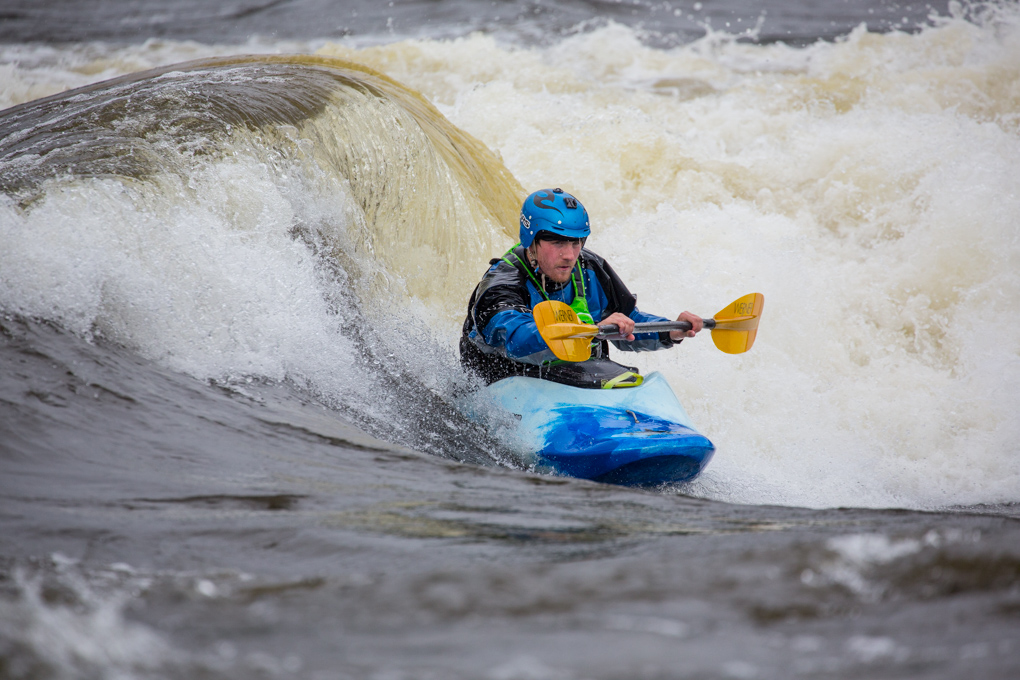
Werner Sherpa Paddle: Bent Shaft
MSRP: $344.95
Manufacturer Specs:
- Weight: 37.2oz
- Blade dimensions: 48 x 19.5cm
- Blade surface: 680 cm2
- Shape: River running
Reviewer Stats:
- Height: 5’10
- Wingspan: 71 inches
Days Tested: 86
Conditions: Class III-V: Play boating, river running, big water, creeking, extreme racing
Locations: Norway, Czech Republic, Germany, Austria
I have paddled with Werner’s fiberglass designs for the majority of my time on the river since 2006. During that time, I’ve had a lot of experience with a variety of their blade shapes, as well as experimenting with straight and bent shaft performance.
I needed a new paddle to bring with me for a full summer in Norway, so I picked up a bent shaft Sherpa with fiberglass blades and a lightweight carbon shaft.
Blades
The main reason I chose the Sherpa over Werner’s other fiberglass models is the blade shape and size. The Sherpa’s blades are shaped similarly to Werner’s other popular river running model, the Powerhouse, but are slightly smaller.
Since I was going to Norway to work as a guide and paddle almost every day, my goal was to minimize the strain that I put on my body over the course of an entire summer on the water. The medium blades still allow me to get a strong purchase on each stroke without getting too exhausted over the course of a long day. Like all Werner whitewater designs, the Sherpa features a modest dihedral. The dihedral shape on the power face minimizes flutter in my strokes and alleviates my tendency to over grip the shaft, without causing interference on in-water recovery strokes.
Although there are larger blades in Werner’s lineup for those who really want maximum power, the Sherpa provides plenty of power on critical strokes. I was able to race to 25th place at the 2014 Adidas Sickline race in Austria while using the Sherpa. The mid-sized blades allowed me to maintain a high paddling cadence when sprinting through the flat sections of the course, without compromising my power on the big boof moves or driving me to early fatigue. Medium blades preserve my energy over time compared to the larger blades on a Werner Powerhouse or an AT Geronimo.
Werner’s fiberglass models come with brightly colored, translucent blades. The Sherpa’s blades are a particularly eye catching yellow/amber color, which makes the paddle easier to spot in the river if you end up swimming or lose the paddle all together.
Shaft
Werner’s bent shaft whitewater models have a carbon shaft that is lightweight, stiff, and durable. The shaft’s texture is smooth and comfortable to hold, but not too slippery. I have not found it necessary to use paddle wax or sticky tape to keep my hands from slipping on the shaft like I need to on AT’s carbon shafts.
A bent shaft is daunting because it is considerable more expensive. Paddles can be easily lost in the event of a swim and can break on big waterfalls, which only increases boaters’ hesitancy to spend an extra $95 on a bent shaft rather than a straight one. For me, however, it is worth it because I have a history of wrist and elbow problems when I am paddling more than five days a week.

Werner’s designs utilize a “neutral bent shaft,” which lines up the blades, hands, and center point of the paddle. This aligns my wrists in an ergonomic position without drastically changing performance characteristics relative to a straight shaft. Other bent shaft designs, like a crank shaft, are more demanding in terms of technique and strength. In my experience, having my knuckles even slightly behind the blade drastically increases the force that I exert on each stroke. This comes down to personal preference and what I’m used to, but I find the neutral bent shaft to be the most naturally comfortable shaft design out there.
A bent shaft also helps me to place my hands in the right spot on the paddle. If I take my hand away to scratch my nose, fix my helmet, turn on a POV camera, or wipe water from my eyes, the curvature of the shaft allows me to place my hands back in the exact position I need instantly and with more confidence compared to a straight shaft.
The extra expense of the bent shaft is worth it personally because it keeps me healthy and on the water. I also have not had too many problems losing or breaking my paddles… knock on wood. If you do not have problems with your wrists or elbows and tend to break or lose paddles frequently, then the bent shaft may not be worth the added expense.
Length
I should be using a 197cm Sherpa according to Werner’s size charts, but I prefer to use the 194cm paddle. I playboat and creek boat roughly equal amounts, and the 194cm seems to work better for me across all conditions. I have also paddled with 197cm paddles, which are excellent for deeper rivers where maximum power matters. The additional length provides more leverage over the blade, which generates more power per stroke, but also puts more strain on the body. The extra length on the 197cm leaves me feeling “tangled up” when playboating and makes it more difficult to get my paddle into position to initiate tricks.

In shallow creeks, I prefer the 194cm Sherpa. The shorter length helps keep my paddle from getting hung up on lurking rocks that could knock me off line and expose my shoulders to injury if the blade gets caught the wrong way.
Boaters who are looking for a paddle that works across all disciplines should consider purchasing one size down from Werner’s recommendations. Werner’s recommendation is likely the right size for you if you are mainly focused on river running and creeking in deeper streams.
Durability
One of the main reasons that I repeatedly purchase Werner’s fiberglass models is for their durability. Since 2005, I have only broken one out of eight fiberglass models that I’ve owned. While I’ve had to sell some in foreign countries and I lost two at the bottom of waterfalls, for the rest, the blades wore down to tiny nubs over extended periods of time.
Only once did one of my Werner paddles fail catastrophically – the blade snapped in half after getting stuck in an underwater notch between two rocks, which was, admittedly, my fault. Werner will put a new blade on your paddle for about half the price of the paddle. While this is pretty steep, it still beats buying a full-priced new paddle.
Any paddle will break under sufficient stress. That is just how it is. We want paddles that are both lightweight and durable, but a piece of gear that comes into contact with rocks on a daily basis can’t last forever. In my experience, Werner’s fiberglass lineup beats carbon and is the most durable mainstream paddle in the business. That is a big deal for safety in addition to being nice for my wallet.
Barring a catastrophic failure from a significant impact, the Werner’s fiberglass blades will wear down over time. Many repeated impacts will reduce the size of your blade, but exactly how long this process takes will simply depend on your how many rocky creeks and slides you paddle. After 86 days on mostly deep water in Europe, this particular Sherpa was still in great shape and had a ton of life left in it.
Carbon vs Fiberglass
Werner has informed me that their in-house testing shows no meaningful difference between the durability and flex of fiberglass and carbon blades (not including foam core blades, which they admit are less impact resistant). My real world experience begs to differ.
On the water, the fiberglass blades feel more flexible, which I like because it transfers less force to my body and leaves me with more energy at the end of the day. I also believe that this increased flex is the reason that the the fiberglass blades are actually more impact resistant than carbon ones. Some people claim that carbon blades are more resistant to wear than fiberglass, but I have not found any difference between carbon and fiberglass in this respect.
Beyond durability, the main tradeoff between these blade materials is simply weight. My advice is that unless you are extremely picky about weight, just save yourself a bit of cash and go with the fiberglass blades. Never go into any paddle purchase thinking you are buying an invincible tool. They break, they get lost, and we all learn it the hard way at some point.
Bottom Line
The Sherpa is currently my favorite blade shape from Werner’s fiberglass lineup. The mid-sized blades work well in all conditions and give me plenty of power without straining my wrists, elbows, and shoulders. I can keep a high paddling cadence and go all day long without experiencing the fatigue that I often feel with bigger blades.
And despite the larger price tag, I prefer the feel of the bent shaft. The Werner Sherpa fiberglass blades offer the best balance of durability, performance, and price that I currently know of.

Great review, just got myself a Sherpa!
I bought a 197cm Powerhouse in 2013 for class 3 river running, it’s now down to 191cm. Going to check out a Sherpa.